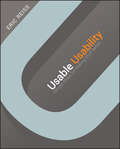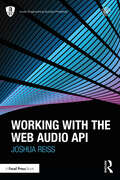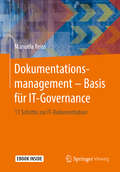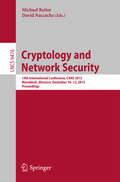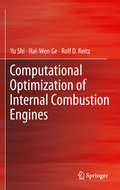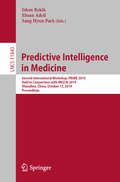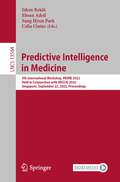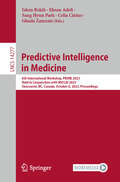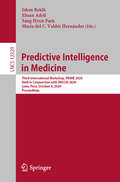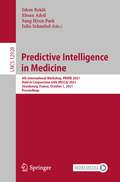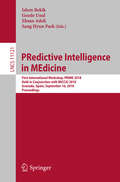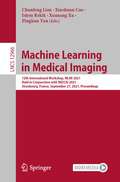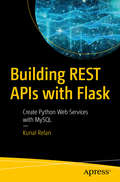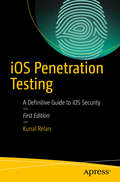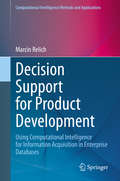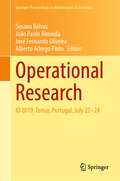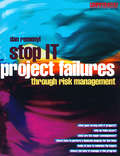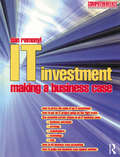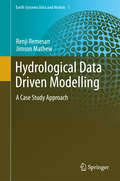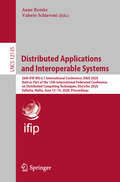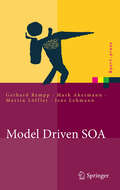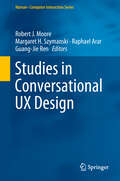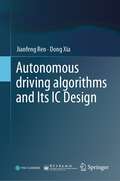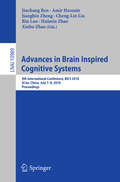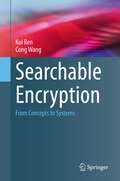- Table View
- List View
Usable Usability: Simple Steps for Making Stuff Better
by Eric ReissThe A-to-Z guide to spotting and fixing usability problems Frustrated by pop-ups? Forms that make you start over if you miss a field? Nonsensical error messages? You're not alone! This book helps you simply get it right the first time (or fix what's broken). Boasting a full-color interior packed with design and layout examples, this book teaches you how to understand a user's needs, divulges techniques for exceeding a user's expectations, and provides a host of hard won advice for improving the overall quality of a user's experience. World-renowned UX guru Eric Reiss shares his knowledge from decades of experience making products useable for everyone...all in an engaging, easy-to-apply manner. Reveals proven tools that simply make products better, from the users' perspective Provides simple guidelines and checklists to help you evaluate and improve your own products Zeroes in on essential elements to consider when planning a product, such as its functionality and responsiveness, whether or not it is ergonomic, making it foolproof, and more Addresses considerations for product clarity, including its visibility, understandability, logicalness, consistency, and predictability Usable Usability walks you through numerous techniques that will help ensure happy customers and successful products!
Working with the Web Audio API (Audio Engineering Society Presents)
by Joshua ReissWorking with the Web Audio API is the definitive and instructive guide to understanding and using the Web Audio API. The Web Audio API provides a powerful and versatile system for controlling audio on the Web. It allows developers to generate sounds, select sources, add effects, create visualizations and render audio scenes in an immersive environment. This book covers all essential features, with easy to implement code examples for every aspect. All the theory behind it is explained, so that one can understand the design choices as well as the core audio processing concepts. Advanced concepts are also covered, so that the reader will gain the skills to build complex audio applications running in the browser. Aimed at a wide audience of potential students, researchers and coders, this is a comprehensive guide to the functionality of this industry-standard tool for creating audio applications for the web.
Dokumentationsmanagement – Basis für IT-Governance
by Manuela ReissIm Buch erfahren Sie nicht nur, warum IT-Dokumentation ein wichtiges Managementwerkzeug ist, sondern auch, wie Sie dieses Werkzeug Schritt für Schritt einrichten und pflegen. Im Fokus steht das von der Autorin entwickelte und in der Praxis erprobte Vorgehensmodell zum Aufbau einer ganzheitlichen und managementorientierten IT-Dokumentation zur Unterstützung von IT-Governance. Mit seinem Glossar leistet das Buch darüber hinaus einen Beitrag zur Standardisierung der Begriffe, die im Umfeld des Themas Dokumentation verwendet werden. Damit richtet sich das Buch an alle, die sich wissenschaftlich fundiert mit der praktischen Umsetzung der IT-Dokumentation auseinandersetzen möchten.
Cryptology and Network Security: 14th International Conference, CANS 2015, Marrakesh, Morocco, December 10-12, 2015, Proceedings (Lecture Notes in Computer Science #9476)
by Michael Reiter David NaccacheThis book constitutes the refereed proceedingsof the 14th International Conference on Cryptology and Network Security, CANS2015, held in Marrakesh, Morocco, in December 2015. The 12 full papers presented together with 6short papers were carefully reviewed and selected from numerous submissions. Thepapers cover topics of interest such as internet of things and privacy;password-based authentication; attacks and malicious code; security modelingand verification; secure multi-party computation; and cryptography and VPNs.
Computational Optimization of Internal Combustion Engines
by Rolf D. Reitz Yu Shi Hai-Wen GeComputational Optimization of Internal Combustion Engines presents the state of the art of computational models and optimization methods for internal combustion engine development using multi-dimensional computational fluid dynamics (CFD) tools and genetic algorithms. Strategies to reduce computational cost and mesh dependency are discussed, as well as regression analysis methods. Several case studies are presented in a section devoted to applications, including assessments of: spark-ignition engines,dual-fuel engines,heavy duty and light duty diesel engines.Through regression analysis, optimization results are used to explain complex interactions between engine design parameters, such as nozzle design, injection timing, swirl, exhaust gas recirculation, bore size, and piston bowl shape. Computational Optimization of Internal Combustion Engines demonstrates that the current multi-dimensional CFD tools are mature enough for practical development of internal combustion engines. It is written for researchers and designers in mechanical engineering and the automotive industry.
Predictive Intelligence in Medicine: Second International Workshop, PRIME 2019, Held in Conjunction with MICCAI 2019, Shenzhen, China, October 13, 2019, Proceedings (Lecture Notes in Computer Science #11843)
by Islem Rekik Ehsan Adeli Sang Hyun ParkThis book constitutes the proceedings of the Second International Workshop on Predictive Intelligence in Medicine, PRIME 2019, held in conjunction with MICCAI 2019, in Shenzhen, China, in October 2019. The 18 papers presented in this volume were carefully reviewed and selected for inclusion in this book. The contributions describe new cutting-edge predictive models and methods that solve challenging problems in the medical field for a high-precision predictive medicine.
Predictive Intelligence in Medicine: 5th International Workshop, PRIME 2022, Held in Conjunction with MICCAI 2022, Singapore, September 22, 2022, Proceedings (Lecture Notes in Computer Science #13564)
by Islem Rekik Ehsan Adeli Sang Hyun Park Celia CintasThis book constitutes the proceedings of the 5th International Workshop on Predictive Intelligence in Medicine, PRIME 2022, held in conjunction with MICCAI 2022 as a hybrid event in Singapore, in September 2022.The 19 papers presented in this volume were carefully reviewed and selected for inclusion in this book. The contributions describe new cutting-edge predictive models and methods that solve challenging problems in the medical field for a high-precision predictive medicine.
Predictive Intelligence in Medicine: 6th International Workshop, PRIME 2023, Held in Conjunction with MICCAI 2023, Vancouver, BC, Canada, October 8, 2023, Proceedings (Lecture Notes in Computer Science #14277)
by Islem Rekik Ehsan Adeli Sang Hyun Park Celia Cintas Ghada ZamzmiThis volume LNCS 14277 constitutes the refereed proceedings of the 6th International Workshop, PRIME 2023, Held in Conjunction with MICCAI 2023, in October 2023, held in Vancouver, BC, Canada. The 24 full papers presented were carefully reviewed and selected from 27 submissions. This workshop intersects ideas from both machine learning and mathematical/statistical/physical modeling research directions in the hope to provide a deeper understanding of the foundations of predictive intelligence developed for medicine, as well as to where we currently stand and what we aspire to achieve through this field.
Predictive Intelligence in Medicine: Third International Workshop, PRIME 2020, Held in Conjunction with MICCAI 2020, Lima, Peru, October 8, 2020, Proceedings (Lecture Notes in Computer Science #12329)
by Islem Rekik Ehsan Adeli Sang Hyun Park Maria del C. Valdés HernándezThis book constitutes the proceedings of the Second International Workshop on Predictive Intelligence in Medicine, PRIME 2020, held in conjunction with MICCAI 2020, in Lima, Peru, in October 2020. The workshop was held virtually due to the COVID-19 pandemic. The 17 full and 2 short papers presented in this volume were carefully reviewed and selected for inclusion in this book. The contributions describe new cutting-edge predictive models and methods that solve challenging problems in the medical field for a high-precision predictive medicine.
Predictive Intelligence in Medicine: 4th International Workshop, PRIME 2021, Held in Conjunction with MICCAI 2021, Strasbourg, France, October 1, 2021, Proceedings (Lecture Notes in Computer Science #12928)
by Islem Rekik Ehsan Adeli Sang Hyun Park Julia SchnabelThis book constitutes the proceedings of the 4th International Workshop on Predictive Intelligence in Medicine, PRIME 2021, held in conjunction with MICCAI 2021, in Strasbourg, France, in October 2021.*The 25 papers presented in this volume were carefully reviewed and selected for inclusion in this book. The contributions describe new cutting-edge predictive models and methods that solve challenging problems in the medical field for a high-precision predictive medicine. *The workshop was held virtually.
PRedictive Intelligence in MEdicine: First International Workshop, PRIME 2018, Held in Conjunction with MICCAI 2018, Granada, Spain, September 16, 2018, Proceedings (Lecture Notes in Computer Science #11121)
by Islem Rekik Gozde Unal Ehsan Adeli Sang Hyun ParkThis book constitutes the refereed proceedings of the First International Workshop on PRedictive Intelligence in MEdicine, PRIME 2018, held in conjunction with MICCAI 2018, in Granada, Spain, in September 2018. The 20 full papers presented were carefully reviewed and selected from 23 submissions. The main aim of the workshop is to propel the advent of predictive models in a broad sense, with application to medical data. Particularly, the workshop will admit papers describing new cutting-edge predictive models and methods that solve challenging problems in the medical field.
Machine Learning in Medical Imaging: 12th International Workshop, MLMI 2021, Held in Conjunction with MICCAI 2021, Strasbourg, France, September 27, 2021, Proceedings (Lecture Notes in Computer Science #12966)
by Islem Rekik Pingkun Yan Chunfeng Lian Xiaohuan Cao Xuanang XuThis book constitutes the proceedings of the 12th International Workshop on Machine Learning in Medical Imaging, MLMI 2021, held in conjunction with MICCAI 2021, in Strasbourg, France, in September 2021.*The 71 papers presented in this volume were carefully reviewed and selected from 92 submissions. They focus on major trends and challenges in the above-mentioned area, aiming to identify new-cutting-edge techniques and their uses in medical imaging. Topics dealt with are: deep learning, generative adversarial learning, ensemble learning, sparse learning, multi-task learning, multi-view learning, manifold learning, and reinforcement learning, with their applications to medical image analysis, computer-aided detection and diagnosis, multi-modality fusion, image reconstruction, image retrieval, cellular image analysis, molecular imaging, digital pathology, etc. *The workshop was held virtually.
Building REST APIs with Flask: Create Python Web Services with MySQL
by Kunal RelanDevelop RESTful web services using the Flask micro-framework and integrate them using MySQL. Use Flask to develop, deploy, and manage REST APIs with easy-to-read and understand Python code. Solve your problem from a choice of libraries. Learn to use MySQL as the web services database for your Flask API using SQLAlchemy ORM.Building REST APIs with Flask provides a primer on Flask, RESTful services, and working with pip to set up your virtual environment. The key differences between NoSQL and SQL are covered, and you are taught how to connect MySQL and Flask using SQLAlchemy. Author Kunal Relan presents best practices for creating REST APIs and guides you in structuring your app and testing REST endpoints. He teaches you how to set up authentication and render HTML using views. You learn how to write unit tests for your REST APIs, and understand mocks, assertions, and integration testing. You will know how to document your REST APIs, deploy your Flask application on all of the major cloud platforms, and debug and monitor your Flask application.What You'll LearnUse MySQL to create Flask REST APIs Test REST endpointsCreate CRUD endpoints with Flask and MySQLDeploy Flask on all of the major cloud platformsMonitor your Flask application Who This Book Is For Python developers interested in REST API development using Flask and web developers with basic programming knowledge who want to learn how Python and REST APIs work together. Readers should be familiar with Python (command line, or at least pip) and MySQL.
iOS Penetration Testing
by Kunal RelanUnearth some of the most significant attacks threatening iOS applications in recent times and learn methods of patching them to make payment transactions and personal data sharing more secure. When it comes to security, iOS has been in the spotlight for a variety of reasons. Although a tough system to manipulate, there are still critical security bugs that can be exploited. In response to this issue, author Kunal Relan offers a concise, deep dive into iOS security, including all the tools and methods to master reverse engineering of iOS apps and penetration testing. What you will learn: * Get a deeper understanding of iOS infrastructure and architecture * Obtain deep insights of iOS security and jailbreaking * Master reverse engineering techniques for securing your iOS Apps * Discover the basics of application development for iOS * Employ security best practices for iOS applications Who is this book for: Security professionals, Information Security analysts, iOS reverse engineers, iOS developers, and readers interested in secure application development in iOS.
Decision Support for Product Development: Using Computational Intelligence for Information Acquisition in Enterprise Databases (Computational Intelligence Methods and Applications)
by Marcin RelichThis book describes how to use computational intelligence and artificial intelligence tools to improve the decision-making process in new product development. These approaches, including artificial neural networks and constraint satisfaction solutions, enable a more precise prediction of product development performance compared to widely used multiple regression models. They support decision-makers by providing more reliable information regarding, for example, project portfolio selection and project scheduling.The book is appropriate for computer scientists, management scientists, students and practitioners engaged with product innovation and computational intelligence applications.
Operational Research: IO 2019, Tomar, Portugal, July 22–24 (Springer Proceedings in Mathematics & Statistics #374)
by Susana Relvas João Paulo Almeida José Fernando Oliveira Alberto Adrego PintoThis book addresses complex real-world problems with recent techniques. It comprises selected papers from the XX. congress APDIO held in Tomar, Portugal, in July 2019. The subject of the book is the application of operational research methodologies and techniques to address complex real problems. Readers will find interesting results and applications of operational research methods and techniques in the wide variety of the addressed problems. Of particular interest are the applications of, among others, linear, nonlinear and mixed-integer programing, multiobjective optimization, metaheuristics and hybrid heuristics, multicriteria decision analysis, data envelopment analysis, clustering techniques and decision support systems, in different areas such as supply chain management, scheduling problems, production management, logistics, energy, telecommunications and finance and health. In most chapters of the book, the described problems, methods and methodologies will be illustrated by auxiliary figures and tables, as well as algorithms. The main benefit of this book is to present the latest trends in operational research methods and methodologies by top Portuguese and international researchers. The book will present a wide scope of complex real-world applications addressed by recent theoretical techniques that aim to narrow the gap between academic researchers and practitioners.
Stop IT Project Failures
by Dan RemenyiThis book is about information systems development failures and how to avoid them. It considers what goes wrong with information systems development projects and what actions may be taken to avoid potential difficulties.The reduction of the impact,or even the elimination of the problems,is discussed in terms of an information systems risk management programme.Stop I.T.Project failure helps to ensure that IS project managers are successful in helping to deliver application systems. However, IS development risk can never be entirely eliminated and consequently the practitioner needs to bear in mind that an IS development project is never without risk, and hence there is a continuing potential for something to go wrong.The book covers the key issues and variables and makes specific practical suggestions about the good management practice that is required to implement IS project risk processes. Dr. Dan Remenyi has spent more than 25 years working in the field of corporate computers and information systems. He has worked with computers as an IS professional, business consultant and user. In all these capacities he has been primarily concerned with benefit realisation and obtaining the maximum value for money from the organisations' information systems investment and effort. He has worked extensively in the field of information systems project management, specialising in the area of project risk identification and management. He has written a number of books and papers in the field of IT management and regularly conducts courses and seminars as well as working as a consultant in this area. Dr.Dan Remenyi holds a B.Soc.Sc., an MBA and a PhD. He is a Visiting Professor at Chalmers University of Technology in Gothenberg, Sweden and an associate member of faculty at Henley Management College in the United Kingdom.
IT Investment: Making a Business Case (Computer Weekly Professional Ser.)
by Dan Remenyi Michael Sherwood-SmithFrequently not enough attention is given to producing a comprehensive business case or to producing an economic justification for an information systems investment. In fact many organizations are not clear as to what constitutes a sound business case and how to go about producing one. This Professional level book for the Computer Weekly Professional Series will show how to go about justification for I.T. spend. This book is designed for all those who are involved in the decision to invest in information systems. This book is especially relevant to senior business executives, senior financial managers and IT executives. Business consultants, computer and corporate advisors will also find the ideas and material addressed in this text of particular benefit as will anyone involved in corporate and strategic planning.In addition, senior students such as those working towards their MBAs will find this book of use.A business case is a statement or a series of statements that demonstrate the economic value of a particular intervention, a course of action or a specific investment. A business case is not simply a financial forecast of the hardware and software costs and the expected benefits. A business case for an information systems investment involves a comprehensive understanding of both the likely resources as well as the business drivers which will assist business managers improve their performance and thereby obtain a stream of benefits from the investment.In general there are approximately six steps in producing a business case for an information systems investment.1. Determine the high-level business outcomes that will be clearly and comprehensively expressed as a set of opportunities the organization can take advantage of, or problems that need to be rectified.2. Identify the corporate critical success factors that will be supported or enhanced by the operation of the completed information systems project or investment.3. Create a list of specific and detailed outcomes or benefits, their appropriate metrics, measuring methods and responsibility points that are represented by the stakeholders.4. Quantify the contribution made by the outcomes, which requires associating numbers or benefit values with outcomes where this is possible.5. Highlight the risks associated with the project.Fundamental to this new approach to developing a business case for information systems investment is the fact that it incorporates much more than the financial numbers which are typically found in the standard approach to a feasibility study. This approach looks behind the financial numbers to the improvements in business performance which are facilitated by information systems and which are the real drivers of the benefits. Furthermore, this approach to developing a business case allows the organization to manage the process so that the required results are achieved.
Hydrological Data Driven Modelling
by Renji Remesan Jimson MathewThis book explores a new realm in data-based modeling with applications to hydrology. Pursuing a case study approach, it presents a rigorous evaluation of state-of-the-art input selection methods on the basis of detailed and comprehensive experimentation and comparative studies that employ emerging hybrid techniques for modeling and analysis. Advanced computing offers a range of new options for hydrologic modeling with the help of mathematical and data-based approaches like wavelets, neural networks, fuzzy logic, and support vector machines. Recently machine learning/artificial intelligence techniques have come to be used for time series modeling. However, though initial studies have shown this approach to be effective, there are still concerns about their accuracy and ability to make predictions on a selected input space.
Distributed Applications and Interoperable Systems: 20th IFIP WG 6.1 International Conference, DAIS 2020, Held as Part of the 15th International Federated Conference on Distributed Computing Techniques, DisCoTec 2020, Valletta, Malta, June 15–19, 2020, Proceedings (Lecture Notes in Computer Science #12135)
by Anne Remke Valerio SchiavoniThis book constitutes the proceedings of the 20th IFIP International Conference on Distributed Applications and Interoperable Systems, DAIS 2020, which was supposed to be held in Valletta, Malta, in June 2020, as part of the 15th International Federated Conference on Distributed Computing Techniques, DisCoTec 2020. The conference was held virtually due to the COVID-19 pandemic. The 10 full papers presented together with 1 short paper and 1 invited paper were carefully reviewed and selected from 17 submissions. The papers addressed challenges in multiple application areas, such as privacy and security, cloud and systems, fault-tolerance and reproducibility, machine learning for systems, and distributed algorithms.
Model Driven SOA
by Gerhard Rempp Jens Lehmann Mark Akermann Martin LöfflerServiceorientierte Architektur (SOA) hat sich durchgesetzt, wer sie beherrscht, hat einen Wettbewerbsvorteil. Deshalb stellt sich meist nicht die Frage, ob SOA angewendet werden soll, sondern wie sie umgesetzt werden kann. Die Autoren geben anhand eines Anwendungsbeispiels einen Überblick über die modellgetriebene Softwareentwicklung. Sie zeigen, wie sich mit Modellierungsnotationen und mit Generatoren die werkzeuggestützte Entwicklung von SOA-Anwendungen effizient und dauerhaft umsetzen lässt. Mit allen notwendigen Sourcecodes und Dokumentationen.
Studies in Conversational UX Design (Human–Computer Interaction Series)
by Guang-Jie Ren Raphael Arar Margaret H. Szymanski Robert J. MooreAs voice interfaces and virtual assistants have moved out of the industry research labs and into the pockets, desktops and living rooms of the general public, a demand for a new kind of user experience (UX) design is emerging. Although the people are becoming familiar with Siri, Alexa, Cortana and others, their user experience is still characterized by short, command- or query-oriented exchanges, rather than longer, conversational ones. Limitations of the microphone and natural language processing technologies are only part of the problem. Current conventions of UX design apply mostly to visual user interfaces, such as web or mobile; they are less useful for deciding how to organize utterances, by the user and the virtual agent, into sequences that work like those of natural human conversation. This edited book explores the intersection of UX design, of both text- or voice-based virtual agents, and the analysis of naturally occurring human conversation (e.g., the Conversation Analysis, Discourse Analysis and Interactional Sociolinguistics literatures). It contains contributions from researchers, from academia and industry, with varied backgrounds working in the area of human-computer interaction. Each chapter explores some aspect of conversational UX design. Some describe the design challenges faced in creating a particular virtual agent. Others discuss how the findings from the literatures of the social sciences can inform a new kind of UX design that starts with conversation.
Autonomous driving algorithms and Its IC Design
by Jianfeng Ren Dong XiaWith the rapid development of artificial intelligence and the emergence of various new sensors, autonomous driving has grown in popularity in recent years. The implementation of autonomous driving requires new sources of sensory data, such as cameras, radars, and lidars, and the algorithm processing requires a high degree of parallel computing. In this regard, traditional CPUs have insufficient computing power, while DSPs are good at image processing but lack sufficient performance for deep learning. Although GPUs are good at training, they are too “power-hungry,” which can affect vehicle performance. Therefore, this book looks to the future, arguing that custom ASICs are bound to become mainstream. With the goal of ICs design for autonomous driving, this book discusses the theory and engineering practice of designing future-oriented autonomous driving SoC chips.The content is divided into thirteen chapters, the first chapter mainly introduces readers to the current challenges and research directions in autonomous driving. Chapters 2–6 focus on algorithm design for perception and planning control. Chapters 7–10 address the optimization of deep learning models and the design of deep learning chips, while Chapters 11-12 cover automatic driving software architecture design. Chapter 13 discusses the 5G application on autonomous drving. This book is suitable for all undergraduates, graduate students, and engineering technicians who are interested in autonomous driving.
Advances in Brain Inspired Cognitive Systems: 5th International Conference, Bics 2012, Shenyang, Liaoning, China, July 11-14, 2012 Proceedings (Lecture Notes in Computer Science #7366)
by Jinchang Ren Amir Hussain Jiangbin Zheng Cheng-Lin Liu Bin Luo Huimin Zhao Xinbo ZhaoThis book constitutes the refereed proceedings of the 9th International Conference on Advances in Brain Inspired Cognitive Systems, BICS 2018, held in Xi’an, China, in July 2018. The 83 papers presented in this volume were carefully reviewed and selected from 137 submissions. The papers were organized in topical sections named: neural computation; biologically inspired systems; image recognition: detection, tracking and classification; data analysis and natural language processing; and applications.
Searchable Encryption: From Concepts to Systems (Wireless Networks)
by Kui Ren Cong WangThis book comprehensively reviews searchable encryption, which represents a series of research developments that directly enable search functionality over encrypted data. The book majorly covers: 1) the design and implementation of encrypted search algorithms, data structures, and systems that facilitate various forms of search over always-encrypted databases; 2) different threat models, assumptions, and the related security guarantees, when using searchable encryption in the real-world settings; and 3) latest efforts in building full-fledged encrypted database systems that draw insights from searchable encryption constructions.The book fits in the timely context, where the necessity of safeguarding important and sensitive data has been globally recognized. Traditional security measures, such as storing data behind network firewalls and layers of access control mechanisms to keep attackers out, are no longer sufficient to cope with the expanding landscape of surging cyber threats. There is an urgent call to keep sensitive data always encrypted to protect the data at rest, in transit, and in use. Doing so guarantees data confidentiality for owners, even if the data is out of their hands, e.g., hosted at in-the-cloud databases. The daunting challenge is how to perform computation over encrypted data. As we unfold in this book, searchable encryption, as a specific line of research in this broadly defined area, has received tremendous advancements over the past decades.This book is majorly oriented toward senior undergraduates, graduate students, and researchers, who want to work in the field and need extensive coverage of encrypted database research. It also targets security practitioners who want to make well-informed deployment choices of the latest advancements in searchable encryption for their targeted applications. Hopefully, this book will be beneficial in both regards.
